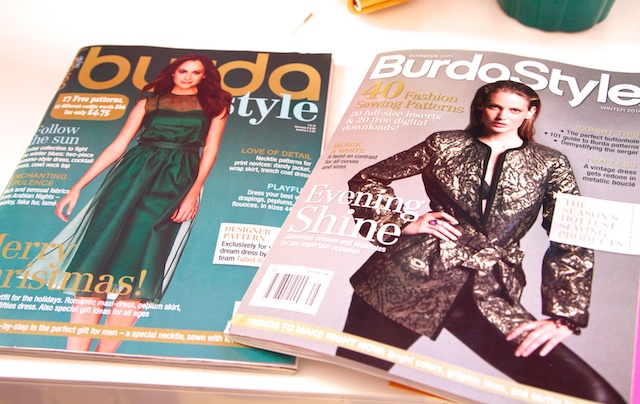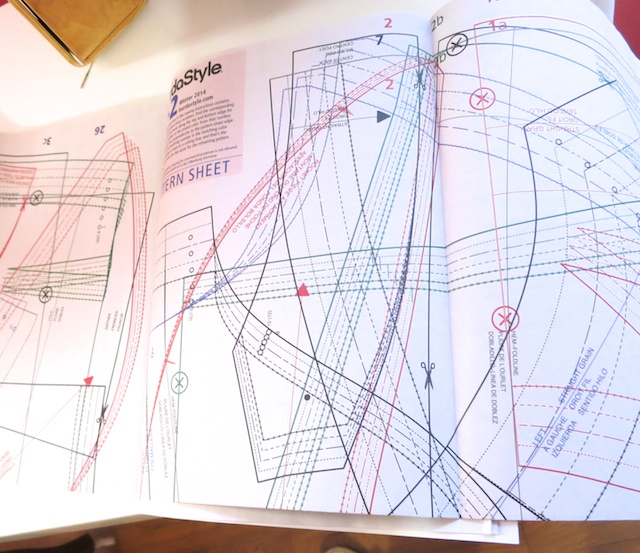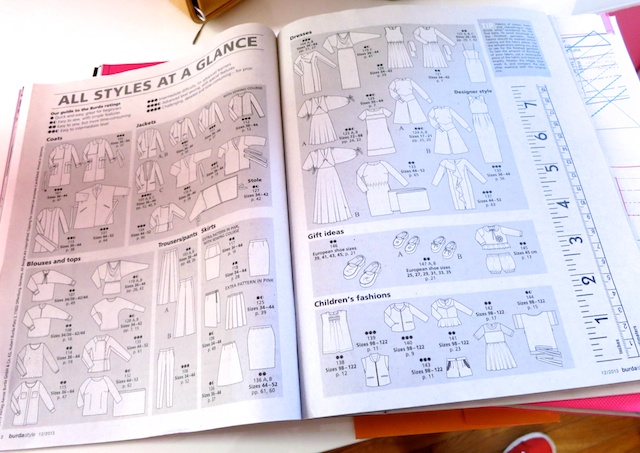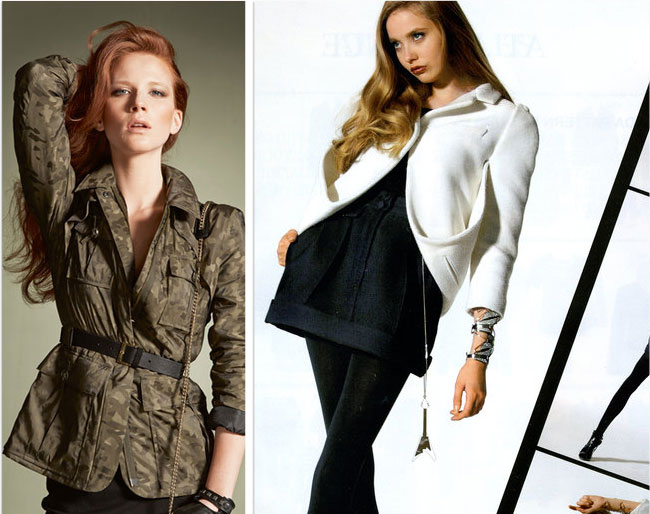
{Burda Style December 2013 and U.S. premiere edition}
I credit Burda magazine for being one of the resources that got me excited about sewing again. For most of my twenties, any time I’d pick up sewing, I’d quickly get very restless and bored with patterns. I had these images in my head but no idea how to turn them into reality. Adding to this mix was a long dusty period where American sewing patterns were so out of tune with style, and local sewing stores turned into craft and quilt emporiums but I wanted… fashion! So I turned to patternmaking classes. I figured I might as well learn to do it myself. Discovering Burda became a cup in the desert. Their style was better in tune with fashion, European, and lookee, a ton of patterns in all one magazine!
After five years of subscribing, it no longer seems like a novelty. Their fashions might seem “normal” now, but there was a time when one could still make a distinction between European and American style. I call it the Pre-Zara era. Now we have global street style (global hipsters…), you know? So much has changed, as the craft of garment sewing flourishes, and with it a flourishing of independent pattern companies and their designers.
And honestly, sometimes I wonder if I need this many sewing patterns. Anything I could want to sew has already been published in Burda and I probably have it somewhere in the stash. But I was more than a little curious about the new American edition. So I picked up a copy from Joann’s last week to compare to my monthly magazines. Here’s a quick lowdown on the differences:
- US edition has four pattern sheets with 20 patterns. It also includes 20 free downloads of the patterns not included on the sheets. (40 patterns in total.) Seven plus-size patterns.
- The Europe issue has two sheets with 17 patterns (and two or three variations on each of those). Six of these are plus-size.
- All of the patterns in the current American Burda were published last winter (between the November and December 2012 issues). So they are running a year behind (for the moment?).
The US edition feels like a Burda re-boot. Since it is the premier edition the first few sections offer an introduction to using and tracing the patterns, and a beginner’s guide to using a serger.
I’m not quite ready to give up on my European subscription but the new magazine has merit. I like the friendlier format with the ability to trace off some patterns and download others. The digital option keeps the pattern sheets less crowded and confusing.
Much easier on the eyes:

The US version doesn’t have all the line drawings on one page, as the European issues do. I wish they’d include this as that is the only way I find stuff in the vast Burda-verse:

Overall, both editions are still incredibly cost-effective. Where else can you get 20-30 patterns for less than the price most independents are charging for single patterns? Of course it’s only valuable if you enjoy Burda patterns in the first place. It’s true that Burda repeats its styles over and over, sometimes with really minor variations. I don’t particularly like their “ethnic/folklore/hippie chic/gypsy” patterns they seem to publish every two months. But hey, those styles must have a following…

I know that Burda puts off beginners, especially North American sewists who didn’t grow up learning from it, who don’t have the same “pattern magazine” tradition that other countries have. I don’t mind tracing off patterns as that’s part of its value–more patterns, less paper cost. In many ways, I really have to thank Burda for making me a better sewist and helping me develop an eye for a good pattern. For example, I don’t mind that I have to add seam allowances. In fact I prefer doing so, because with Burda I know exactly where the seamlines are, and have more control over how much allowance I add. I like small allowances in waistbands, facings and pocket openings, and learning to do that has improved my sewing immensely. And I rarely have to check the accuracy of the drafts–the seams match, they meet at 90 degrees important places, etc.–like I do with some patterns. I love trying new styles from independent companies but some really do suffer from poor pattern engineering.
There are two things Burda does very well and frequently: jackets and trousers. In my collection of issues, they’ve published every style of jacket imaginable: trench coats, duffel coats, anoraks, blazers, and in many variations. Same with trousers and jeans. If I’m looking for a pattern or a particularly classic style, even if it’s just to research changes to another company’s pattern, I shop my Burda “library” first.


Some day I’m going to tackle that Lagerfeld pattern (white jacket on the right). That issue been sitting out on my coffee table for two years!
Would you like tips and inspiration in the craft of lingerie sewing? Sign up for my weekly eletter The Lingerie Maker.

i agree with so many things you wrote here.. burda has a special place in my heart too, as i sew almost exclusively with burda patterns from the very first day i started sewing (i just got so comfortable with their patterns, that i see no reason to even try out another company)..
also, i’m planing to make that lagerfeld skirt for ages (as jacket won’t really work for my frame.. and i really feel like i need to have a lagerfeld something in my closet)
This is such an interesting perspective! I really appreciate the value of Burda patterns. I’m impressed, though, by anyone that can learn to sew with Burda– that’s seriously awesome! I just made a simple Burda cardigan, and, in my opinion, you need to already have an idea of how to put it together because the directions really didn’t make any sense. That said, they have so many cool styles that the big 4 just can’t touch that I think it’s worth it to struggle through the lack of directions!
I’m new to sewing and frightend of their patterns. I did get the 1st US magazine edition and loved the designs within. It came with a good ‘how-to’ article and to give me greater confidence with my 1st Burda pattern, I also purchaded the Burda Sewing Handbook to accomany me on this journey. I’m planning on tackling my first pattern (no seam allowance and all) this weekend. If I pull it off, I too may be a convert!
Hi Scooter, I hope it works out for you! I know it can be a paradigm shift having to do things so differently than you do with tissue patterns. They really are great patterns, though!
i think that once upon a time people were more exposed to sewing and knew the basics, hence burda’s sparse instructions. in this day and age, people are picking up sewing later in life as a hobby and don’t have the assumed background knowledge. i was excited to see the US burda come out, but i was a bit miffed to find the designs were all a year old! granted, i love many of them and hadn’t bought/sewed them yet, so it wasn’t a waste. it’s just puzzling as to why they didn’t release the current patterns. i’ll probably buy the subscription since it’s such a bargain, and hopefully they’ll get up to speed with the current design offerings!
Thanks for the info on the US magazine!
I think your point about their pattern drafting is really spot on: we have yet to discover a Rosetta stone to understand their instructions, but their patterns themselves are always very well put together, and their sizing is also very reliable. I return to Burda again and again. To me, they’re like what Phildar is in knitting.
I’ve been using Burda magazines since 1993 & have seen huge changes in them, but I still faithfully buy every issue. It’s true they recycle looks & overall the styles seem to be getting “easier” and less interesting, but I just know that the month I decide to stop, they will be awesome! I would prefer them to go back to 4 pattern sheets though, my eyes aren’t as good as they were 20 years ago! 🙂
Hi Anne, I have some 90s issues, too and I agree, they had some more tailored styles back then. I also keep thinking I’m going to stop subscribing (usually in the summer when the issues seem to get really boring) but then I worry I’ll miss out on some really cool stuff!
Great post Amy! I agree that Burda has a special place in my heart. I’ve never had a subscription, so I’m sure I’m missing out on some of the ‘Burda-experience’ but their website, downloadable patterns, and online community was such a huge resource to me when I was teaching myself to sew. I know that wasn’t THAT long ago, but it does really seem since then that the indie pattern market and the home sewer interested in fashion has kind of exploded (perhaps this is just perception as I become more aware of what’s out there?) and somewhere along the way I sort of lost touch with Burda. I really think the economy of Burda’s patterns just can’t be beat. Sure you get some duds in each magazine, but even if there are 2 patterns you’re interested in having, that’s still a huge deal. I also like the idea of having back issues of magazines as a sort of library.
It sounds like you have quite the library! There were some good things I found in Burda Magazines for wedding dress patterns, there are so few good ones out there.
You know, I’ve never picked up one of Burda’s magazines and I should. That Lagerfeld jacket is incredible!
Maddie, you should check it out that Lagerfeld pattern just to look at the pattern drafting. It is a really unique pattern! (I think burdastyle.com has it for download.)
It’s so interesting to read your opinions about Burda. I live in Europe, I grew up with it. My grandma used to sew from it, Burda is what I know… For me the US patterns are confusing… especially when I should make adjustments… It’s strange that I can’t see where I should sew… I don’t really care about measuring seam allowances when I sew Burda, just add some space and I follow the sewing line.
But it’s true that their sewing directions are not as good as US ones (I’ve just bought an easy dress pattern, with 38 pages instructions – amazing) . Their sewing book is a great help, and you should read the directions step by step, every word counts… I could never understand the whole when I read through it… 🙂
I love hearing the European perspective on Burda… I grew up sewing with Vogue and McCalls and Simplicity so Burda was a strange new world! At this point in my sewing journey I don’t use pattern directions anymore, unless it is a very unusual pattern– so I’ve never minded the cursory instructions in Burda. I can certainly understand how it confuses people who didn’t learn from it or are coming to it as a brand-new sewist. Hopefully the American version will begin to flesh them out a bit!
I absolutely love Burda magazines, but then I grew up using them as “normal” so never got the fear. I can see though how the written instructions with no pictures might be scary to a beginner. I think the magazine ethos has always assumed that girls are being taught to sew by their mothers from an early age, which isn’t so common now as it once was.
Hi Carolyn, you are so lucky to have gotten Burda in Australia. (I know we have the crazy $1.99 Vogue sales–I lived for those as a teenager!) It does seem like the American version is making an attempt to cater their instruction to new learners, which is a great idea.
Hello!
First of all, great post! But I just read one thing which I can’t get of my mind. You state that due to globalization fashion taste has become globally the same. I’m a Dutch girl, living in The Netherlands but once in while visiting with old friends living in San Fransisco, CA. I just couldn’t help but stare at all the people walking around in pajama look a likes and the amount of running shoes worn as normal sneakers. Holland may not be as fashionable as for example France or England, but I do believe that the differences between the USA and The Netherlands are highly visible…
Hi Florence, I really thank you for commenting! I’m so fascinated with Dutch fashion. Dutch men dress so colorfully and I really miss seeing that every day. I lived in Prague and then Antwerp for several years so I know what you mean by larger cultural differences. Americans love their athletic wear!
I didn’t mean to say that taste has become the same, because taste is really bound by many cultural aspects, some very practical. Perhaps I should have made a distinction between taste and trends. I do think that fashion trends have crossed global borders more than ever. There are particular subcultures, especially some of the hipster subcultures, that look nearly the same from London to Austin. So you find more of the same in different nations–because of the internet, because of global high street stores that basically sell the same clothes with the same visual styling in every country. One winter I traveled from Berlin to Antwerp back to Austin and went to a Zara in each city. I saw women wearing some of the same sweaters, in the same colors. That just wouldn’t have happened when I was a teenager. Back then I was only exposed to fashion trends via U.S. magazines but now look at style from all over the world every day. That really changes the visual inspiration field.
Thanks for making me think a bit more about that!
I am from Canada. I agree to a point about the globalization of style.
That is why I sew. I don’t want to wear the uniform. Burda is more European. It looks different than American fashion, at least in styling.
I absolutely agree with everything you said, especially about adding seam allowances 🙂
Also, Burda pattern instructions are maybe not so explicit, but are OK. If you read it slowly couple of times, you get it. In my country, Burda Magazine is only in German. No English version here. So many years trying to figure out how to sew only by technical drawings and my imagination.
I don’t agree with you at all!
I’m at my second pattern making with Burda and the fitting is terrible, it seems they design for stocky women with big frames and medium breasts..and I am not a model size myself! Rather a mediterranean type.
The back is too roomy, the waist is not defined, hips too tight, pulling at the chest and back since the armholes are too large …so ill fitting, is it me, only???
Last week I was in a fabric shop, here in Paris, and chatting with some other lady customers there I heard that it’s apparently known amongst the experienced, that you should go for a size smaller than yours because Burda designs are made for ‘vikings women’, as theses ladies said. 🙂
Love from Paris
Viking women! That’s funny. I love the way Burda patterns are drafted–especially in the shoulders. The sleeves are narrower than many American patterns. They do have deep armholes, which I don’t like. I have a rather tiny ribcage and small breasts, so I don’t know about the stocky part. I would think Burda’s patterns might give trouble for women with a small ribcage and large bust. The problem with a lot of ladies pattern drafting is that the back size gets bigger as the bust gets bigger. But there are many women that have most of their bust width in front.
What I do appreciate about Burda is that the patterns are engineered well. I don’t have to walk the seams and make sure things match up. I have to fix a lot of other patterns. How they fit is a separate issue to me… I never expect any company’s patterns to fit me perfectly unless I draft it myself ;).